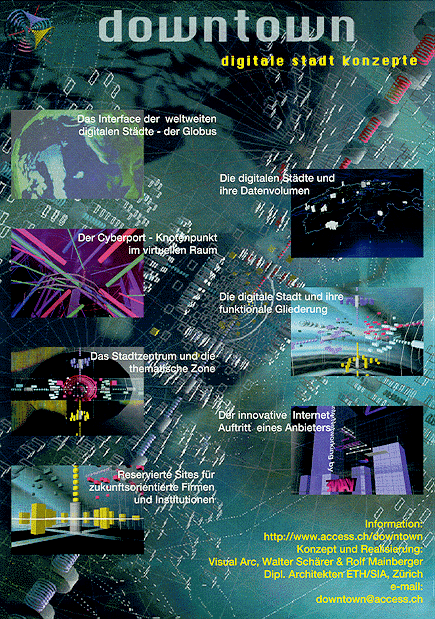Visualization of a «digital city» in the metaverse: What does it look like when data lives?
Concept by Walter Schärer and Rolf Mainberger. Thesis of the master study Computer Aided Architectural Design CAAD at the ETH Zurich from October 1996, professorship of Prof. Dr. Gerhard Schmitt.
Metaverse implementation as an animated, interactive 3D environment using VRML and Javascript on an Onyx computer from Silicon Graphics with Reality Engine2 graphics card.
Bump up the volume for a stronger 3d effect!
From our website from 1996:
What is downtown?
downtown is a future system of virtual cities on the Internet, also known as metaverse.
The three-dimensional interface offers access to a worldwide net of digital cities as they come into being around the world.
Web3 offers an open standard for building such worlds as opposed to the centralised walled gardens of web2.
What does downtown provide?
downtown offers intelligent navigational aids in the form of virtual, digital cities.
Government, businesses and private people are enabled to present themselves in cyberspace and to introduce their services and products.
How is downtown created?
As architects we develop threedimensional corporate design and concepts.
downtown – the globe as an interface
 The Interface to the digital city – the Globe.
The Interface to the digital city – the Globe.
Digital cities are a virtual reflection of real cities or townships.
downtown combines these systems in an intelligent and logical way.
A virtual globe is a convenient interface to all existing and developing digital cities around the world. At any point on the globe, you can access and zoom in on the available data.
downtown – digital cities in Switzerland
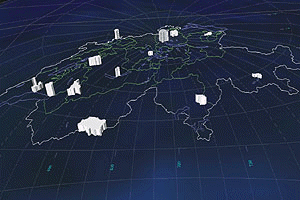 Digital cities and their data volumes.
Digital cities and their data volumes.
Within individual states these sites are interconnected by a network of links.
Their properties and positions are determined by the community-boundaries and further factors such as the number of frequentations.
downtown – cyberport
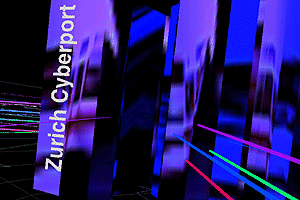 The cyberport – a virtual junction in virtual space.
The cyberport – a virtual junction in virtual space.
At the cross-roads lie the cyberports. They enable travel to all the digital cities of the globe.
Directly connected to them is the according city. The cyberport is analog to an airport, the point of connection for cybercoordinates spread worldwide.
Different terminals lead to regional, national, continental and interkontinental sites in the net.
downtown – functional structure
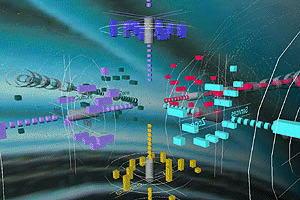 The digital city and its functional structures.
The digital city and its functional structures.
The city itself is oriented towards a centre. From here thematic axis with according color coding spread out into space in all directions since there is no gravity in the cyberspace.
downtown – city centre
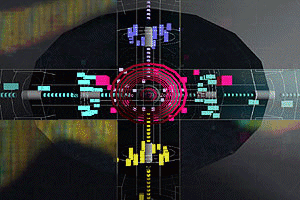 The city centre and its thematic zones.
The city centre and its thematic zones.
Along these zones diverse virtual sites are provided that can be rented by interested providers and adapted to the requirements of the tenent.
downtown – business presentations
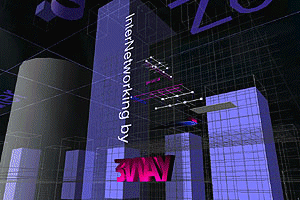 The innovative Internet presentation of the web service-provider 3way.
The innovative Internet presentation of the web service-provider 3way.
Within this volume the tenent can set up his individual internet-representation.
downtown – reserved sites
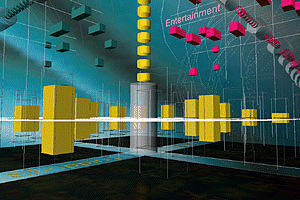 Reserved sites for future-oriented companies and institutions.
Reserved sites for future-oriented companies and institutions.
It is still possible to reserve sites close to the centre. The wireframe representation shows all available sites.
Solid volumes represent reserved sites, finished sites with their individual services and information are recognised by the three-dimensional company logo of the owner.
downtown – sponsors
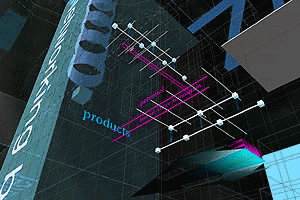 Develop your cyberspace corporate design!
Develop your cyberspace corporate design!
Sponsors of downtown recieve the best sites and additional attractive advertising opportunities, such as the presence of their company logo at important intersections in the system and the inclusion of advertising posters on the different transportation means of the city.
As cyberspace councelors we translate your ideas into brand related architectural concepts.
‹downtown› is Walter Schaerer’s and Rolf Mainberger’s 3D visualization concept from October 1996, i.e. pre SecondLife and pre Google Earth ;-)
How I know this is a Metaverse
After we had presented the supposedly newly invented concept to about 20 friends, two of them independently came up and announced that they had already seen it…
We insisted that it wasn’t possible since we had sifted through the web for similar concepts (in 1996 you could be almost sure to have ’searched› the web) and there was no comparable thing around.
But they both also insisted and told us to read the book Snow Crash (Affiliate Link to Amazon) by Neal Stephenson.
The first thing I did after the bookseller handed me over the book with a wink and a ‹have fun!› was to check for the images our friends had alluded to.
To my dismay there were no images at all!
Only after reading the book did it dawn on me that reading this awesome science fiction had triggered the very images with our friends that we had created in our virtual world.
And of course, I couldn’t agree more with what I was reading ;-)

In view of the 30th anniversary of the publication of the sci-fi novel, I now found illustrations after all that actually bear a resemblance to our visualization: Sotheby’s auctioned off the last originals of the 1992 book documents in March 2023. Among them was a «mood board» by the artists who collaborated with the author.
It presumably shows a damper system for hoverboards, but resembles our 3D structure in its abstracted representation.
Author Neal Stephenson on the Metaverse
Sci-fi author Neil Stephenson, the inventor of the term «metaverse,» names buildings and trees as components of metaverses, according to this interview in the Financial Times.
Interestingly, this does not coincide with the impressions of readers of his book Snow Crash.
I believe that metaverses will fail as long as they try to virtually represent our reality: That is not the point of a «meta «verse.
Rather, it must represent something virtual that we cannot experience in reality.
Or why should we want to change into a poor image of our reality without sun, shadows, wind, smell, etc.?
Metaverses must look as if you were on drugs! Otherwise it’s just no fun ;-)
Here are a few impressions of a Metaverse concept I may be working on someday soon.
Virtual Reality Update from October 2017
During a visit to Zurich’s «Grafik 17» exhibition, I meet 3D and compositing artist Claudio Antonelli of fottergraph.is in the virtual reality area.
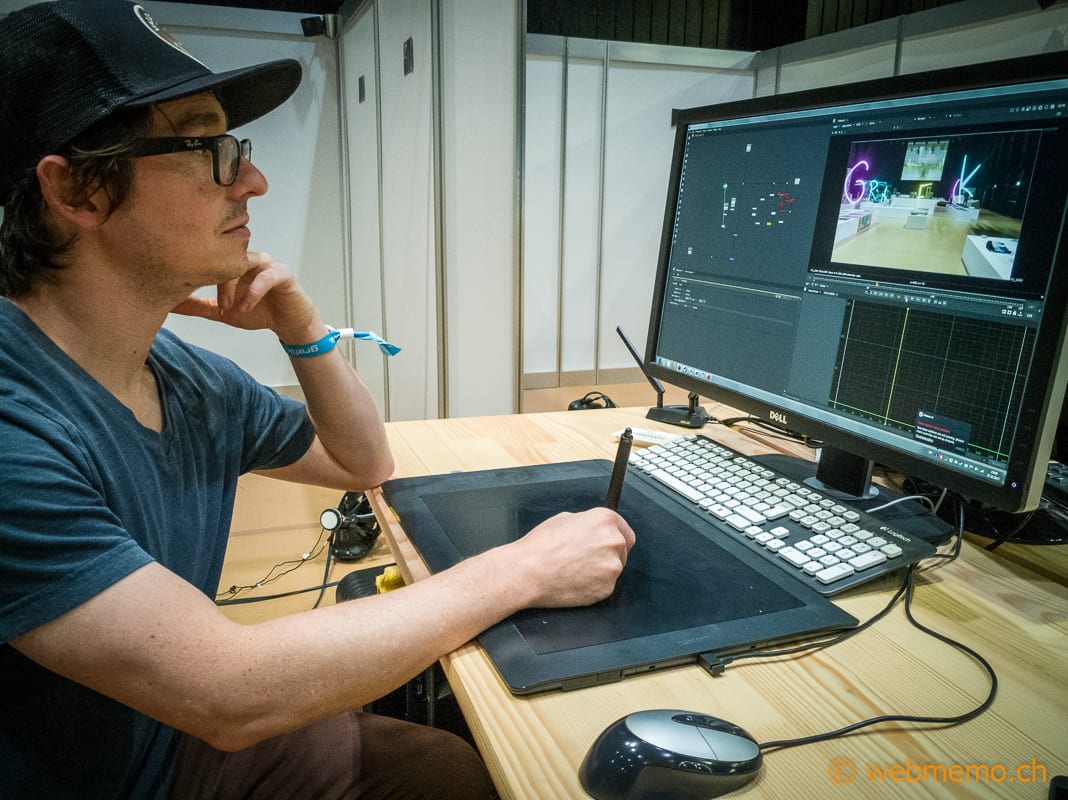
Talking to Claudio, I try to date myself by 11 years of 3D development in a short procedure.
My conclusion: The computers cost only a fraction of what they did back then, the 3D glasses are rather clunkier and heavier than our CrystalEyes back then, but the concepts for VR are not yet more advanced.
In virtual reality, there is obviously no gravity, no climate boundaries, no building authorities. But still, no convincing concept is yet tangible that will make the population flock to cyberspace. Virtual buildings and trees won’t do the trick.
At that time, we had a hard time with the navigation in 3D alone. Over time, we learned to animate the navigation elements in front of the camera so that visitors didn’t get lost.
This now seems to be solved by holding physical controllers in your hand and keeping them in the virtual field of view at all times.
Google’s Tilt Brush, for example, enables intuitive 3D light painting in this way.
But otherwise, the 3D world itself still looks eerily deserted and inhospitable.
The modeling tools still strongly resemble those from the last millennium. Instead of CosmoWorld, they are now called NukeX, for example, and offer a node graph, 3D modeler and a preview window, just like back then.

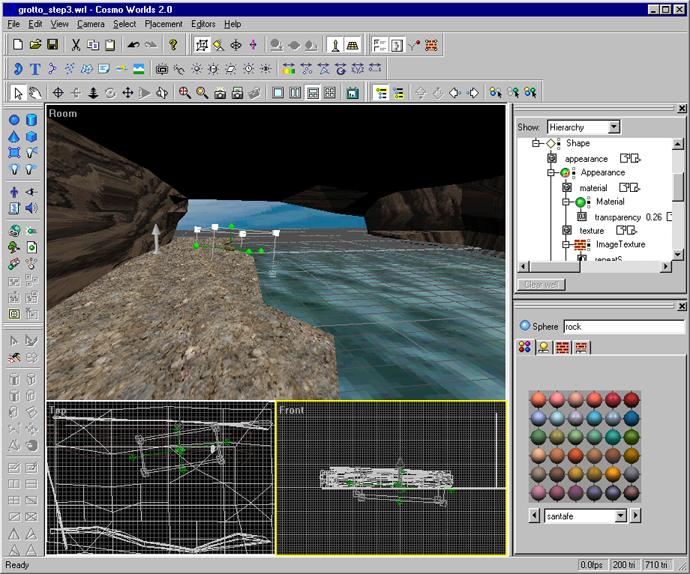
For the implementation of virtual reality projects, Claudio works with frontend specialist Pascal Achermann from frontend-nerds.ch.
That, too, seems to have remained the same: Successful projects require a dynamic, interdisciplinary team.

